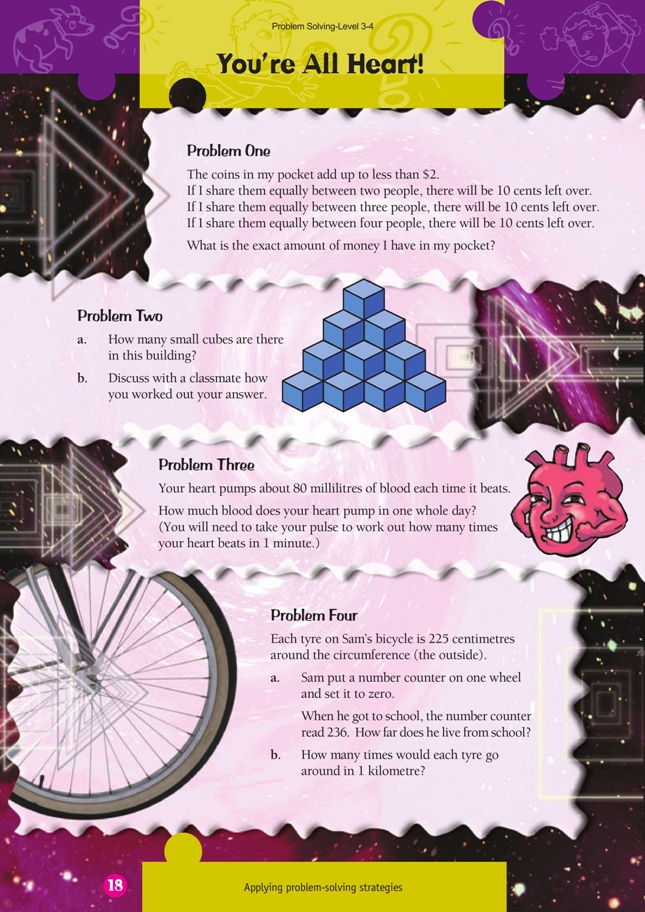These are level 4 number, and measurement problems and level 3 algebra problems from the Figure It Out series.
A PDF of the student activity is included.
Click on the image to enlarge it. Click again to close. Download PDF (370 KB)
use common multiples to solve problems (Problem 1)
identify a pattern in a stack of cubes (Problem 2)
use multiplication to sovle problems involving multiplication (Problem 3)
solve measurement problems inovling conversions between metric untis (Problem 4)
Problem One
Like Problem Four, page 14, this problem involves common multiples. Begin by considering the problem without the extra 5 cents. This can be added on later. The amount must be made up in coins, so it must be able to be divided by 5 (the smallest coin). Find the lowest common multiple of 2, 3, 4, and 5. 2 x 3 x 4 x 5 = 120. Check to see if this is the lowest common multiple by halving it and seeing whether it can still be divided evenly by all the numbers. 60 ÷ 2 = 30, 60 ÷ 3 = 20, 60 ÷ 4 = 15, 60 ÷ 5 = 12. Can it be halved again? No, 30 ÷ 4 = 7.5, so 30 is not a common multiple. Can 20 be the lowest common multiple? No, 20 ÷ 3 = 6.66. So 60 is the lowest
common multiple. So the amount of money is 60 cents + 5 cents or any multiple of 60 cents + 5 cents that is less than $2, that is 65 cents, 125 cents, or 185 cents.
Problem Two
The students should be able to see the pattern in this building. The number of cubes added to each new bottom layer increases by one each time. So the number of cubes in each layer is:
first layer 1
second layer 1 + 2 = 3
third layer 1 + 2 + 3 = 6
fourth layer 1 + 2 + 3 + 4 = 10
Altogether, there are 1 + 3 + 6 + 10 = 20 cubes.
Students may recognise these numbers as triangular numbers or they may see that from a bird’s-eye view, the diagram is a triangle and hence the numbers will be triangular.
Students can check their calculations by making the building with cubes and counting how many they needed.
Problem Three
This problem links to the Measurement strand of the curriculum because students will need to learn how to accurately measure their pulse, and it could also form part of a health unit.
Suppose that a student’s heart beats 100 times a minute. (The normal range for a 10- to 11-year-old is 90–110 beats per minute.) Then their heart will pump 80 x 100 millilitres of blood per minute.
The student’s heart pumps 80 millilitres of blood every beat and beats 100 times per minute. There are 60 minutes in an hour and 24 hours in a day. The amount of blood pumped is 80 x 100 x 60 x 24 = 11 520 000 millilitres per day. There are 1 000 millilitres in a litre, so this is 11 520 litres per day. To help the students to visualise how much 11 520 litres is, they could calculate the amount of water in a full bath or a swimming pool, calculate how many litres would fit in their classroom (remembering that 1 litre is 1 cubic metre), or calculate how far 11 520 1-litre milk containers would stretch if they were laid end to end.
Problem Four
The wheel has gone around 236 times on Sam’s way to school, and each time it goes around, it covers 225 centimetres. Sam lives 236 x 225 centimetres from school. This is 53 100 centimetres or 53 100 ÷ 100 = 531 metres (just over half a kilometre). If the students have difficulty with this concept, you could model it with a trundle wheel or have the students measure the circumference of a round object, roll it along a surface for one revolution, and measure the distance it has covered (which will be the same as the circumference).
To answer part b, the students need to find out how many 225 centimetres there are in 1 kilometre. 1 kilometre = 1 000 metres = 100 000 centimetres. So the wheels turn 100 000 ÷ 225 = 444.4
times.
Hints for Students
1. How can you find an amount that can be divided evenly by 2, 3, or 4?
Remember that you have to be able to make the amount in coins.
2. Try using equipment or drawing a diagram. Can you see a pattern in the number of cubes in each layer?
3. Try an easier problem first. For example, how much blood does your heart pump in a minute? Build up.
4. What distance does Sam’s bike wheel travel when it goes around once?
Answers to Problems
1. There are three possible answers: 65c, $1.25, or $1.85.
2. a. 20
b. Explanations may vary. The hidden part of each layer is the same as the row above. So the number is:
1 + (1 + 2) + (1 + 2 + 3) + (1 + 2 + 3 + 4)
= 1 + 3 + 6 + 10
= 20.
3. Answers will vary, depending on your pulse rate. For example, if your pulse rate is 100 per minute, your heart would pump 80 x 100 x 60 x 24 = 11 520 000 mL of blood in one day. (This is 11 520 L.)
4. a. 531 m
b. Approximately 444 times (the exact answer is 444.4)
